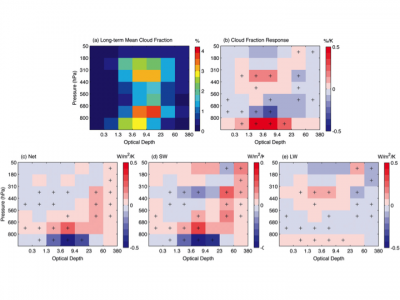An Analysis of the Short-Term Cloud Feedback Using Satellite Data
The cloud feedback in response to short-term climate fluctuations is estimated using a novel technique in which the radiative impact of cloud changes are computed directly from satellite-observed cloud changes associated with interannual climate variability. This represents an advance from previous studies that have typically estimated the cloud feedback as a residual or have inferred it using other indirect measures. Because the technique makes use of histograms of cloud fraction segregated into seven cloud top pressure and seven cloud optical depth categories, it allows for an unprecedented view of the cloud types that contribute to this feedback.
The researchers used cloud radiative kernels -- which measure the radiative effect cloud fraction anomalies—to quantify the cloud feedback due to interannual fluctuations in cloud properties measured by the Moderate Resolution Imaging Spectroradiometer (MODIS) on NASA’s Terra satellite over the period 2000-10. Because the TOA radiation anomalies are computed directly from the satellite-observed cloud changes, it represents a direct estimate of the feedback, unlike other studies to date. Moreover, it allows for much greater understanding of the cloud types that contribute to the feedback.
The researchers find that the global average shortwave (SW), longwave (LW), and net cloud feedbacks are +0.30 ± 1.10, -0.46 ± 0.74, and -0.16 ± 0.83 W m-2 K-1, respectively. It is shown that the apparently small control that global mean surface temperature exerts on clouds, which leads to the large uncertainty in the short-term cloud feedback, arises from statistically significant but offsetting relationships between individual cloud types and global mean surface temperature. Specifically, whereas low clouds provide a strong negative cloud feedback by reflecting more SW radiation to space, midlevel clouds provide a positive net cloud feedback. High clouds make only a small contribution to the net cloud feedback because of a close cancellation between large LW and SW cloud feedbacks. Segregating the clouds by optical depth, it is found that the net cloud feedback is set by a positive cloud feedback due to reductions in the thickest clouds (mainly in the SW) and a cancelling negative feedback from increases in clouds with moderate optical depths (also mainly in the SW).
The researchers have quantified the short-term cloud feedback from cloud fraction anomalies measured directly from space. They have also shown how different cloud types contribute to the feedback. Despite the short-term cloud feedback being rather small and having large uncertainties, this study has shown that it arises from large and statistically significant, but offsetting relationships among individual cloud types.
This work of the authors from Texas A&M University was supported by NSF Grant AGS-1012665 to Texas A&M University. CZ acknowledges support from NASA Earth and Space Science Fellowship Grant NNX12AN57H to Texas A&M University. The contribution of MDZ was performed under the auspices of the U.S. Department of Energy by Lawrence Livermore National Laboratory (LLNL) under Contract DE-AC52 07NA27344 and was supported by the Regional and Global Climate Modeling Program of the Office of Science at the U. S. Department of Energy.

